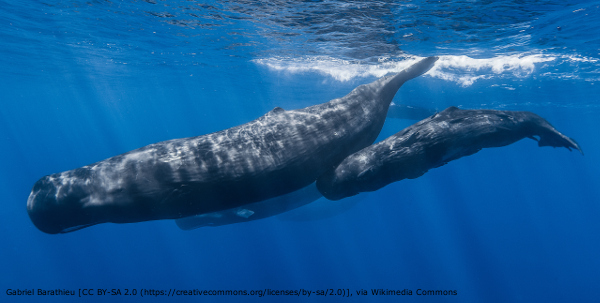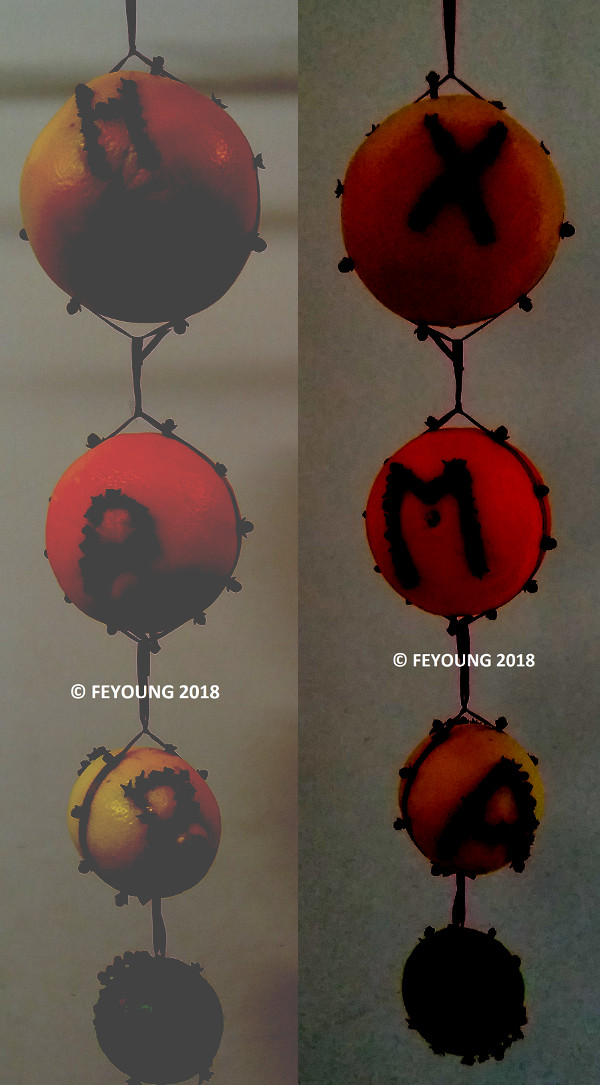by Fi Young
 As a child I remember my grandparents giving a pomander as a Christmas gift. Their pomander was made from an orange studded with cloves, and I don’t mean cloves of garlic unless you want to ward off vampires, but that’s another story!
As a child I remember my grandparents giving a pomander as a Christmas gift. Their pomander was made from an orange studded with cloves, and I don’t mean cloves of garlic unless you want to ward off vampires, but that’s another story!
But is that all to the pomander? Well actually no! The history of the pomander dates back to at least the 14th Century.
We know that aromatic plants were in use well before the pomander. Thyme, Lavender, Rosemary and Peppermint (Mint or Lamiaceae family) were used (circa 5,000 years ago) by the Egyptians to purify the body during mummification [1] and by the Chinese in incense burners for religious ceremonies [2].
The earliest made pomanders were segmented balls made of gold, silver or silver gilt with perforated patterns to allow the aromas to disperse. Each segment would have contained a different scented herb depending on the owners preference and availability. The Victoria & Albert Museum, London have several pomanders on display. One of which is an apple shaped silver pomander made in Italy circa 1350 (see image) [3]. Although pomanders tended to be shaped like fruit, in particular pomegranates, apples, oranges and tomatoes, they could also be box-shaped, vases, skull shaped, scented pouches even shaped as a harp. Many were vases or boxes placed on tables to scent a room [4].

L0058230 Selection of gold and silver pomanders, Europe
Credit: Science Museum, London. Wellcome Images
Precious metals would have been expensive to purchase so pomanders would have been worn only by the wealthy. A pomander tended to be worn around the neck as a pendant, as a bracelet, at the end of a girdle or several pomanders were hung on a rosary [5].
But why wear a pomander? It is suggested that they were worn for three reasons: to hide the stench of body odour (prior to regular bathing becoming the norm), the smell of sewage in street gutters and to ward off diseases, especially The Black Death outbreak of the 1300s.
A major problem was that the lifespan of any aromatic herb was short lived; so to extend this, herbs were mixed with the delicately perfumed and rare Ambergris which is where Sperm Whale (Physester macrocephalus) Poo enters our story.
 Ambergris is formed when some indigestible squid beaks and pens pass through the Sperm whale’s intestines (rather than usually vomited). On their way to the anus these beaks and pens damage the intestinal wall which in turn secretes mucus. It is the mixture of these three substances that form ambergris. It is said that only 1% of Sperm whales produce ambergris and is usually found floating in oceans, seas or washed up on beaches across the world. Some 5% of beached whale carcasses contain ambergris [6].
Ambergris is formed when some indigestible squid beaks and pens pass through the Sperm whale’s intestines (rather than usually vomited). On their way to the anus these beaks and pens damage the intestinal wall which in turn secretes mucus. It is the mixture of these three substances that form ambergris. It is said that only 1% of Sperm whales produce ambergris and is usually found floating in oceans, seas or washed up on beaches across the world. Some 5% of beached whale carcasses contain ambergris [6].
The pomander name comes from the Middle English Anglo-French pomme d’ambre which means apple or ball of amber which relates specifically to the use of ambergris.

No sign of a pomander in this photo but many plants on the dress. Elizabeth I, Hardwick Hall Painting
With the building of boats, and the exploration of distance lands, other herbs and spices were discovered, several coming from the Spice Islands of Indonesia (Maluku or Molucca Islands in the 1600s) : Cloves, Nutmeg and Mace. Transporting these new spices was fraught with dangers of the seas, trying to prevent the crop from rotting combined with the lengthy journey back to Europe and the U.K. Therefore these new spices were extremely expensive so only the wealthiest of the wealthy would have used them. An even smaller subset of these people would have used an entire nutmeg seed for a pomander – talk about showing off your status! Both men and women wore pomanders and Queen Elizabeth I was often seen wearing a pomander pendant.
As this is only a brief history I will jump ahead to Victorian times. Pomanders come in a larger variety of shapes and uses. The Chinese wore Jade pendants, Christmas tree baubles, rings on the fingers, coat hangers, inside heads of walking sticks, inside wedding poses, ceramics, gourds, cushions, even inside a perforated Coquilla nuts [7], a fruit of the Piassava Palm tree a species endemic to the Atlantic coast of Brazil (Attalea funifera Mart. Ex Spreng.).
And so my story returns to the orange and clove pomander to focus in particular on the orange. Oranges (Citrus or Rutaceae family) are classified into three groups : sweet (Citrus sinensis (L.) Osbeck), bitter (Citrus aurantium L.) and the Mandarin loosed skinned-easy peelers (Citrus reticulata Blanco) [8]. Oranges are evergreen trees growing 6-10m in height and crop abundantly from their 50th year onwards. It is common for one tree to yield 100-300 oranges. Unlike other fruit, oranges must be picked when ripe as they do not ripen during transportation. According to worldstopexports.com 2017 global orange export sales was US$5 billion (yes billion!). Spain is responsible for 25% of exports topping US$1.3 billion, with South Africa and United States second and third respectively. [9] Florida has the orange as its official state fruit and produces the majority of the worlds’ orange juice along with Brazil. Oranges in Florida are picked from October to June with the greatest cropping from December to May. Should you get the opportunity to be in the Valencia region of Spain -known as The Orchard of Spain during the cropping season December to February why not take a guided tour of an orchard where two thirds of Spanish oranges are grown.
So did I make pomander for this article? Yes, but I thought I would make a pomander with a twist of my own. Rather than using one citrus fruit I would use four : a red grapefruit, an orange, a lemon and a lime. So with my four fruits, some ribbon and a packet of cloves I made a pomander mobile with a Christmas message (see below). As to the smell of my flat – who needs artificial air fresheners!
You can read more of Fi Young’s work on her website: http://www.lacistemataceae.org
References
[1] Perfume.com (2018Nov30) Perfume and the Egyptian Mummification Process available online at https://www.perfume.com/article-perfume-and-the-egyptian-mummification-process
[2] Wikipedia (2018Nov30) Religious use of incense available online at https://en.wikipedia.org/wiki/Religious_use_of_incense
[3] The Victoria & Albert Museum (2018Nov30) Image of a Pomander from 1350 available online at http://collections.vam.ac.uk/item/O13437/pomander-unknown/
[4] Wikimedia Commons (2018Nov30) Silver Pomanders available online at https://commons.wikimedia.org/w/index.php?search=silver+pomanders&title=Special:Search&go=Go
[5] Wikimedia Commons (2018Nov30) Pomander Rosary available online at (https://commons.wikimedia.org/w/index.php?search=pomander+rosary&title=Special%3ASearch&profile=advanced&fulltext=1&advancedSearch-current=%7B%22namespaces%22%3A%5B6%2C12%2C14%2C100%2C106%2C0%5D%7D&ns6=1&ns12=1&ns14=1&ns100=1&ns106=1&ns0=1).
[6] Natural History Museum (2018Nov30) What is Ambergris? Available online at http://www.nhm.ac.uk/discover/what-is-ambergris.html
[7] Google Images (2018Dec01) Coquilla nut pomander available online at https://www.google.com/search?client=firefox-b-ab&biw=1024&bih=644&tbm=isch&sa=1&ei=meUDXJ7jKozZgQaspKbACg&q=coquilla+nut+pomander&oq=coquilla+n&gs_l=img.3.0.35i39j0j0i30l2j0i8i30j0i24l2.36464.38132..38893…0.0..0.135.806.9j1……1….1..gws-wiz-img…….0i67j0i10i67.u2xOwLFZMTs
[8] Idealspain.com (2018Nov30) Exploring Spain – Oranges in Spain available online at http://www.idealspain.com/pages/information/oranges-spain.html
[9] Worldtopexports.com (2018 May 11) Oranges Exports by Country available online at http://www.worldstopexports.com/oranges-exports-by-country/



Pingback: #AdventBotany 2018, Day 3: The Pomander – a smorgasbord of Lamiaceae and Rutaceae with a pinch of Sperm Whale Poo — Culham Research Group « Herbology Manchester